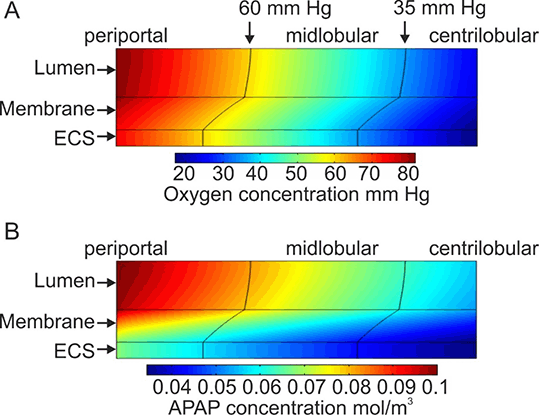Print version
Search Pub Med
| 010P London, UK Pharmacology 2016 |
Mathematical modelling of a liver hollow fibre bioreactor
INTRODUCTION: Current 2D in vitro test systems are poorly predictive of the toxicity of chemicals entering the systemic circulation [1]. There is therefore an urgent need for models of systemic toxicity with improved predictivity. We are currently developing a hollow fibre bioreactor (HFB) system for hepatotoxicity testing. Previously HFBs have shown promise for use as bioartificial livers and their use in hepatotoxicity testing is a natural extension to this work [2,3,4]. To assist with the development of the HFB, the design has been mathematically modelled to inform its operating set up and aid in optimizing design to mimic hepatic physiological conditions.
METHODS: Based on in vitro data, a cell-scale in silico cellular metabolism model was derived to describe the kinetics of cellular drug uptake, metabolism and excretion. The cell-scale model was then incorporated into a model for a functional liver sinusoid. Sinusoid fluid flow was then incorporated as advection-diffusion rate equations. Whole body predictions were obtained by representing the liver as a collection of in silico sinusoids and incorporating this into a physiologically based pharmacokinetic (PBPK) framework.
RESULTS: The analysis of this model has produced novel results that allow the operating set up to be calculated and predictions of compound clearance generated. The model predicts the inlet oxygen concentration and flow rate that gives a physiological oxygen gradient in the HFB to mimic a liver sinusoid. It has also been used to predict the concentration gradients and clearance of a test drug, paracetamol (APAP). The effect of altering the HFB dimensions and fibre properties on paracetamol clearance under the condition of a physiological oxygen gradient is analysed.

Fig. 1: Computer simulation of concentration gradients of (A) oxygen and (B) APAP within a hollow fibre bioreactor seeded with primary rat hepatocytes with zonal regions indicated.
CONCLUSIONS: Our predictions indicate that APAP clearance for a fixed inlet dose is likely to be significantly sensitive to the density of cells, membrane permeability and width. These theoretical predictions can be used to design the most appropriate experimental set up and data analysis to quantitatively compare the functionality of cell types that are cultured within the HFB to those in other systems.
REFERENCES: 1Godoy P et al. Archives of Toxicology. (2013) 87:1315-530. 2Allen JW et al. Toxicological Sciences. (2005) 84:110-9. 3Jasmund I et al. Biotechnology Progress. (2002) 18:839-46. 4Lu HF et al. Tissue Engineering. (2005) 11:1667-77.

